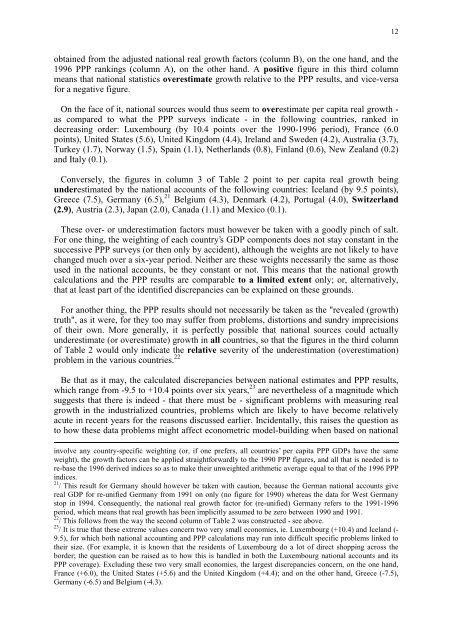Did the Swiss Economy Really Stagnate in the 1990s, and Is ...
Did the Swiss Economy Really Stagnate in the 1990s, and Is ...
Did the Swiss Economy Really Stagnate in the 1990s, and Is ...
You also want an ePaper? Increase the reach of your titles
YUMPU automatically turns print PDFs into web optimized ePapers that Google loves.
12<br />
obta<strong>in</strong>ed from <strong>the</strong> adjusted national real growth factors (column B), on <strong>the</strong> one h<strong>and</strong>, <strong>and</strong> <strong>the</strong><br />
1996 PPP rank<strong>in</strong>gs (column A), on <strong>the</strong> o<strong>the</strong>r h<strong>and</strong>. A positive figure <strong>in</strong> this third column<br />
means that national statistics overestimate growth relative to <strong>the</strong> PPP results, <strong>and</strong> vice-versa<br />
for a negative figure.<br />
On <strong>the</strong> face of it, national sources would thus seem to overestimate per capita real growth -<br />
as compared to what <strong>the</strong> PPP surveys <strong>in</strong>dicate - <strong>in</strong> <strong>the</strong> follow<strong>in</strong>g countries, ranked <strong>in</strong><br />
decreas<strong>in</strong>g order: Luxembourg (by 10.4 po<strong>in</strong>ts over <strong>the</strong> 1990-1996 period), France (6.0<br />
po<strong>in</strong>ts), United States (5.6), United K<strong>in</strong>gdom (4.4), Irel<strong>and</strong> <strong>and</strong> Sweden (4.2), Australia (3.7),<br />
Turkey (1.7), Norway (1.5), Spa<strong>in</strong> (1.1), Ne<strong>the</strong>rl<strong>and</strong>s (0.8), F<strong>in</strong>l<strong>and</strong> (0.6), New Zeal<strong>and</strong> (0.2)<br />
<strong>and</strong> Italy (0.1).<br />
Conversely, <strong>the</strong> figures <strong>in</strong> column 3 of Table 2 po<strong>in</strong>t to per capita real growth be<strong>in</strong>g<br />
underestimated by <strong>the</strong> national accounts of <strong>the</strong> follow<strong>in</strong>g countries: Icel<strong>and</strong> (by 9.5 po<strong>in</strong>ts),<br />
Greece (7.5), Germany (6.5), 21 Belgium (4.3), Denmark (4.2), Portugal (4.0), Switzerl<strong>and</strong><br />
(2.9), Austria (2.3), Japan (2.0), Canada (1.1) <strong>and</strong> Mexico (0.1).<br />
These over- or underestimation factors must however be taken with a goodly p<strong>in</strong>ch of salt.<br />
For one th<strong>in</strong>g, <strong>the</strong> weight<strong>in</strong>g of each country’s GDP components does not stay constant <strong>in</strong> <strong>the</strong><br />
successive PPP surveys (or <strong>the</strong>n only by accident), although <strong>the</strong> weights are not likely to have<br />
changed much over a six-year period. Nei<strong>the</strong>r are <strong>the</strong>se weights necessarily <strong>the</strong> same as those<br />
used <strong>in</strong> <strong>the</strong> national accounts, be <strong>the</strong>y constant or not. This means that <strong>the</strong> national growth<br />
calculations <strong>and</strong> <strong>the</strong> PPP results are comparable to a limited extent only; or, alternatively,<br />
that at least part of <strong>the</strong> identified discrepancies can be expla<strong>in</strong>ed on <strong>the</strong>se grounds.<br />
For ano<strong>the</strong>r th<strong>in</strong>g, <strong>the</strong> PPP results should not necessarily be taken as <strong>the</strong> "revealed (growth)<br />
truth", as it were, for <strong>the</strong>y too may suffer from problems, distortions <strong>and</strong> sundry imprecisions<br />
of <strong>the</strong>ir own. More generally, it is perfectly possible that national sources could actually<br />
underestimate (or overestimate) growth <strong>in</strong> all countries, so that <strong>the</strong> figures <strong>in</strong> <strong>the</strong> third column<br />
of Table 2 would only <strong>in</strong>dicate <strong>the</strong> relative severity of <strong>the</strong> underestimation (overestimation)<br />
problem <strong>in</strong> <strong>the</strong> various countries. 22<br />
Be that as it may, <strong>the</strong> calculated discrepancies between national estimates <strong>and</strong> PPP results,<br />
which range from -9.5 to +10.4 po<strong>in</strong>ts over six years, 23 are never<strong>the</strong>less of a magnitude which<br />
suggests that <strong>the</strong>re is <strong>in</strong>deed - that <strong>the</strong>re must be - significant problems with measur<strong>in</strong>g real<br />
growth <strong>in</strong> <strong>the</strong> <strong>in</strong>dustrialized countries, problems which are likely to have become relatively<br />
acute <strong>in</strong> recent years for <strong>the</strong> reasons discussed earlier. Incidentally, this raises <strong>the</strong> question as<br />
to how <strong>the</strong>se data problems might affect econometric model-build<strong>in</strong>g when based on national<br />
<strong>in</strong>volve any country-specific weight<strong>in</strong>g (or, if one prefers, all countries’ per capita PPP GDPs have <strong>the</strong> same<br />
weight), <strong>the</strong> growth factors can be applied straightforwardly to <strong>the</strong> 1990 PPP figures, <strong>and</strong> all that is needed is to<br />
re-base <strong>the</strong> 1996 derived <strong>in</strong>dices so as to make <strong>the</strong>ir unweighted arithmetic average equal to that of <strong>the</strong> 1996 PPP<br />
<strong>in</strong>dices.<br />
21 / This result for Germany should however be taken with caution, because <strong>the</strong> German national accounts give<br />
real GDP for re-unified Germany from 1991 on only (no figure for 1990) whereas <strong>the</strong> data for West Germany<br />
stop <strong>in</strong> 1994. Consequently, <strong>the</strong> national real growth factor for (re-unified) Germany refers to <strong>the</strong> 1991-1996<br />
period, which means that real growth has been implicitly assumed to be zero between 1990 <strong>and</strong> 1991.<br />
22 / This follows from <strong>the</strong> way <strong>the</strong> second column of Table 2 was constructed - see above.<br />
23 / It is true that <strong>the</strong>se extreme values concern two very small economies, ie. Luxembourg (+10.4) <strong>and</strong> Icel<strong>and</strong> (-<br />
9.5), for which both national account<strong>in</strong>g <strong>and</strong> PPP calculations may run <strong>in</strong>to difficult specific problems l<strong>in</strong>ked to<br />
<strong>the</strong>ir size. (For example, it is known that <strong>the</strong> residents of Luxembourg do a lot of direct shopp<strong>in</strong>g across <strong>the</strong><br />
border; <strong>the</strong> question can be raised as to how this is h<strong>and</strong>led <strong>in</strong> both <strong>the</strong> Luxembourg national accounts <strong>and</strong> its<br />
PPP coverage). Exclud<strong>in</strong>g <strong>the</strong>se two very small economies, <strong>the</strong> largest discrepancies concern, on <strong>the</strong> one h<strong>and</strong>,<br />
France (+6.0), <strong>the</strong> United States (+5.6) <strong>and</strong> <strong>the</strong> United K<strong>in</strong>gdom (+4.4); <strong>and</strong> on <strong>the</strong> o<strong>the</strong>r h<strong>and</strong>, Greece (-7.5),<br />
Germany (-6.5) <strong>and</strong> Belgium (-4.3).
















